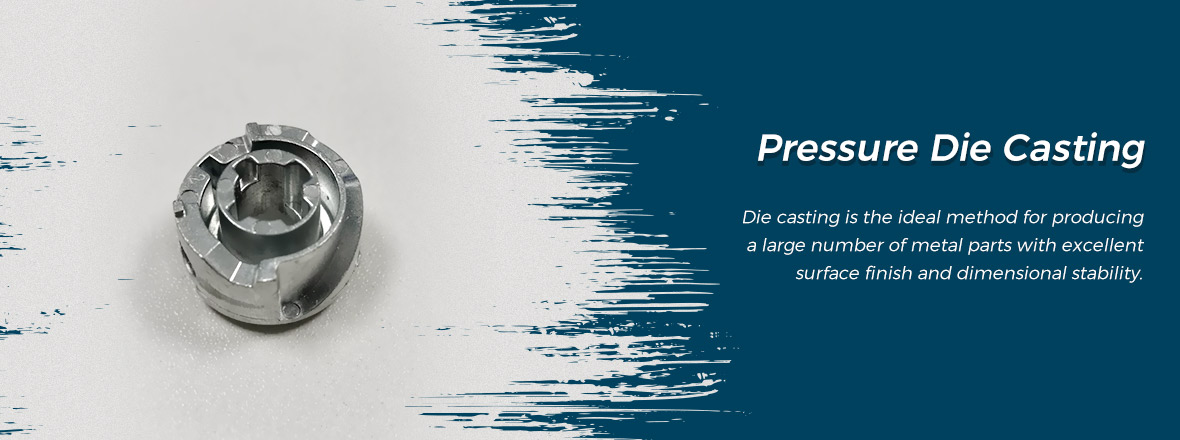Pressure Die Casting
Pressure die casting is a metal casting process. It is characterized by applying high pressure to the molten metal using the mold cavity. Molds are usually machined from stronger alloys, a process similar to injection molding. Most die castings are iron-free, such as zinc, copper, aluminum, magnesium, lead, tin, and lead-tin alloys and their alloys. Depending on the type of die casting, a cold chamber dies casting machine or a hot chamber die casting machine is required.
Pressure casting is a special casting method that has developed rapidly in modern metal processing technology with little or no cutting. It is the process of filling molten mold under high pressure and high speed and crystallizing and solidifying under high pressure to form castings. High pressure and high speed are the main features of pressure casting. The commonly used pressure is tens of MPa, the filling speed (in-gate speed) is about 16 to 80 m / s, and the time for filling the mold cavity with metal liquid is extremely short about 0.01 to 0.2 seconds.
Advantages of the pressure die casting
Die casting is the ideal method for producing a large number of metal parts with excellent surface finish and dimensional stability.
HPDC's production cycle includes:
1.ショットスリーブへの金属の計量。
2.プランジャーの動き。
3.迅速なダイ充填。 スチールダイは、通常200〜300°Cで潜熱を放散します。
4.凝固中、鋳造物はプランジャーによって水圧で加圧され、凝固収縮を供給します。 大きな圧力に耐えるために最大4000トンのロック力が市販されてい
ます。5。ダイが開きます。
6.次に鋳造物が排出されます。 水力エネルギーは、金属の位置、速度、プランジャーの加速度を制御して、充填および凝固中の流れと圧力を最適化できるコンピューター化されたシステムによって提供されます。
Application of Pressure Die Casting
部品の数は、プロトタイプ部品の50または100から数千の大量生産要件までさまざまです。これらはすべて、すべてのプロジェクトに適用される慎重かつ正確な方法で製造されます。
- ホイール、ブロック、シリンダーヘッド、マニホールドなどの自動車部品。
- 航空宇宙鋳造。
- 電気モーターハウジング。
- 圧力鍋などの台所用品。
- エレクトロニクス産業用キャビネット。
- 一般的なハードウェアアプライアンス、ポンプ部品、配管部品。
Essai's die casting equipment has the ability to process internal molds and can produce molds with a weight of 2.5KGS and a size of up to 500x500x250mm. We have 10 die-casting machines with clamping forces ranging from 80T to 630T. The commonly used casting materials are aluminum (usually ADC10 / 12 and A380) and zinc (3 # / 5 #). Castings can also be subjected to a large number of second processes in Essai's own processing facilities, as well as various cosmetic processes including powder coating, spray coating, anodizing, polishing, and electroplating.
1. High pressure dies casting can be divided into "cold-chamber" and "hot-chamber" processes.
2. In the cold-chamber process, molten metal is metered into a cold chamber for each machine cycle (or shot).
3. The molten metal is then forced by a single plunger through a narrow feeder channel (or gate), into the die cavity itself, by the application of pressures from 7 to 207 MPa.
4. The metal solidifies rapidly because the die is water-cooled within a fraction of a second.
5. Upon solidification, the dies are opened and the casting is removed using ejector pins.
6. Most of the castings will have flash where the two die halves come together. This is usually removed in a trimming die.
7. The high cost of dies (up to £250,000) and the capital cost of machines (£175,000–£350,000) limit this process to the high volume production of components.
8. Hot-chamber die casting is limited to the low melting point magnesium and zinc alloys, where contamination by the iron will be less extensive. A gooseneck shot sleeve is submerged in a heated pot of molten melt. A plunger descends and forces the molten metal into the die. As the piston retracts, the cylinder is filled with metal.
1. High pressure dies casting is restricted to the lower melting point alloys.
2. The bulk of die casting is carried out in zinc-, magnesium- and aluminum-based alloys.
3. The most popular zinc-based alloys (known as Mazak) contain 3.8–4.3% aluminum and 0.10–1.25 wt% copper, with tensile strengths of 293–355 MPa, and elongations of 3–4%. Zinc alloys have a higher impact strength than die-cast aluminum alloys.
4. There is six main aluminum die casting alloys used in the UK. All contain 4–13 wt% silicon, which is used to promote good castability. The most common alloy is LM6-M (BS 1490), which contains 10–13% silicon, and has a tensile strength of 280 MPa and an elongation of 2–5%.
5. The strict melting practice is required with magnesium-based alloys, which are mainly used on hot-chamber machines. The most popular alloy contains 9–10% aluminum and 1% zinc, achieves a tensile strength of 215 MPa and an elongation of 2%.
6. The degree of retained porosity in the die casting affects the properties of the product.
今すぐビジネスを始めましょう!
問い合わせ




